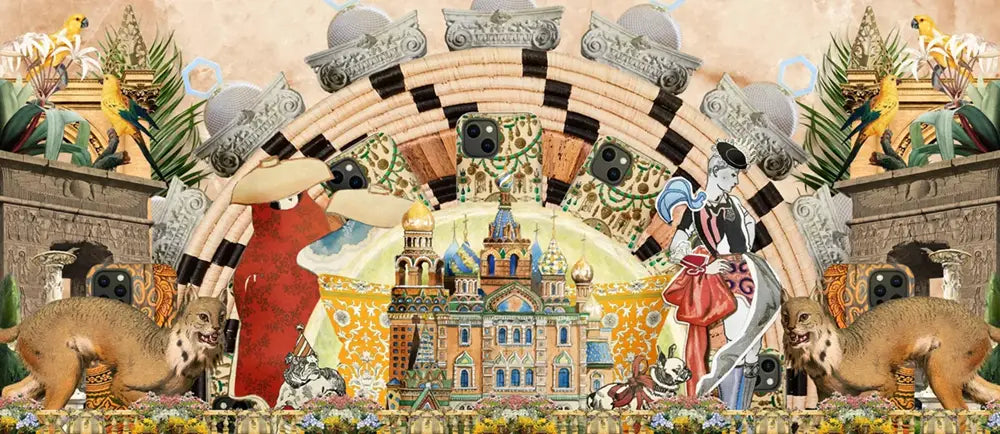Step into the sun-washed hush of a canvas that dissolves time and empire. Here, Denon is both cartographer and conjurer, mapping Egypt’s sands with a scholar’s eye and a poet’s pulse. His own likeness becomes a bridge—one foot in Parisian salons, the other in the dust of forgotten temples.
Key Takeaways
-
Discover how Denon’s self-portrait upends the usual hierarchy of observer and observed, turning empire into introspection.
-
Uncover the scroll’s double life as both relic and manifesto, where knowledge and power intertwine.
-
See how the smallest glint—a gold braid, a drop of sweat—speaks volumes about diplomacy dressed as drama.
-
Explore the portrait’s afterlives: from fuelling Egyptomania to igniting today’s debates on museum repatriation.
-
Feel the roles reverse as East and West hold each other in view, challenging who truly claims the gaze.
A Desert Vision in Oil
The canvas glows like a mirage—Denon’s dark eyes reflecting dunes that never were, yet feel uncannily real.¹ He stands in a crisp uniform, tricorne tilted, every fold of wool as precise as hieroglyphs incised in sandstone. A bare-chested attendant leans forward, offering a scroll or vessel whose shape drifts at the edge of legibility. Sand drifts across brushstrokes—dust and memory entwined. The painting invites you to step into its heat, to feel the grit beneath your sandals.
Here, the artist becomes both subject and storyteller. Dominique-Vivant, Baron de Denon—the polymath who taught Europe to see Egypt—casts himself as explorer, curator, conqueror.² Behind him, imagined palms arch like silent sentinels; before him, a silent exchange bridges two worlds. Every pigment hums with imperial promise and the tremor of discovery. This is no mere likeness of a man, but a hymn to an age when empires rose on curiosity’s wings.
-
Colonial Imagery: Denon’s figure, in Western attire, implies control and civilization. The other figure’s near-nudity and oriental turban signal the exotic and eroticized Orient.
-
Cultural Exchange: At the same time, their pose—face to face—hints at a meeting of worlds. The Egyptian leans toward Denon, offering what seems to be a scroll or vase (the precise object eludes us), as if sharing knowledge or paying tribute.
-
Intimacy & Power: Modern critics have picked up a homoerotic subtext—some describe the scene as “courting” rather than scholarly consultation. Whether intentional or subconscious, the closeness of the two men breaks from strictly formal portraiture. It suggests a secret rapport across cultural lines.
Artist Becomes the Subject
Denon’s journey began with engraving plates in Paris salons—etching noble profiles by day, debating Locke by night.³ He served as diplomat in London, rubbed elbows with philosophes, then answered Bonaparte’s call in 1798. In the Egyptian sands, he swapped chalk for camel, sketchbook for tomb, morphing observer into archivist.⁴ His two-volume Voyage dans la Basse et la Haute Égypte (1802) erupted onto French parlor tables, its plates of rotting sphinxes and flood-scarred temples electrifying the public imagination.⁵
By 1804, Denon wore many hats—literally and figuratively. Napoleon named him director of the Musée Napoléon; Joséphine bundled jewels and obelisks for her Malmaison gallery.⁶ Yet he craved a different immortality: his own image distilled in oil. The self-portrait tradition ran deep in French academic circles—David’s austere countenance, Girodet’s dramatic light—but Denon’s canvas dared something rarer: situating himself amid the land he helped canonize. He authored his legend with bristles and pigments.
Egypt as Stage
Napoleon’s Egyptian venture was as much performance as conquest. Letters home described pyramids “like mountains toppled by gods,” while field artists sketched every obelisk and scorpion.⁷ The Institut d’Égypte swallowed journals of soil samples and papyrus fragments by day, hosted soirées of scientific magic at night.⁸ In 1809, Description de l’Égypte began rolling off the press—forty plates of gleaming columns, crocodile rituals, pharaonic banquets that seeded French Baronial décor for decades.⁹
Denon moved within this spectacle, part chronicler, part impresario. He negotiated with Mamluk beys for temple access, dodged fever in Upper Egypt’s ruins, and cajoled craftsmen to cast plaster for Paris exhibitions.¹⁰ His portrait stands at this intersection: Europe’s curiosity made flesh beside the land of dead kings. The backdrop—suggested pyramids, sand-blown horizons—makes Egypt both setting and character. Here, art imitated life, and life became legend.
Brushstrokes of Power
Every stitch of Denon’s uniform speaks diplomacy. The black cloth, buttoned tight, carves a silhouette of order against the desert’s formless amber.¹¹ Epaulettes glint like miniature pyramids, symbols of rank as insistent as the sun. The attendant’s bare chest offers a counterpoint: flesh unguarded, skin anthracite in the glare. Their proximity conveys more than protocol—a whisper of trust, even intimacy, without uttering the word.¹²
Light dances across textures: the wool’s soft matte, the papyrus scroll’s brittle sheen, the attendant’s turban folding like dunes in the breeze.¹³ Béra’s palette is restrained—earth ochres, umbers, ivory highlights—yet charged by contrast. The tricorne’s shadow frames Denon’s brow, underlining his gaze’s intensity. A drop of sweat glistens on his temple, the only concession to the desert’s heat. In silence, every detail negotiates authority.
Metaphors Woven in Fabric
The scroll or vase offered by the attendant is more than prop—it is the catalyzing metaphor of encounter.¹⁴ Is it knowledge passed between cultures, or tribute rendered to a conqueror? Sand drifts across its surface—time’s erasure and revelation in one gesture. Threads of empire are encoded in that gesture: a gift, a demand, a ceremony of power.
Denon’s uniform becomes tapestry of meaning. Each gold braid is a river of conquest, each button a carved relief recalling temple friezes.¹⁵ The attendant’s turban coils like papyrus scrolls—nature folded into culture, culture folded back into devotion. Together, they enact a palimpsest: art writing over history writing over desire. Here, the painting unspools a larger story of memory and myth.
Afterlives—Museums and Memory
Denon’s afterlife glimmers in the Louvre’s Denon Wing—vast halls of antiquities whose foundation he laid.¹⁶ He brokered the plunder of Italy’s greatest canvases, coaxed the Rosetta Stone to Paris, and oversaw acquisitions that defined Western taste. Yet his personal canvas—the 1804 portrait—remains backstage, a private manifesto of empire and empathy.
Egyptian Revival swept through Paris salons: obelisk-topped lamps, sphinx-headed furniture, Napoleon’s tomb crowned by lotus capitals.¹⁷ Denon’s portrait fueled that craze, a celebrity snapshot emblazoned on broadsides and prints. In modern retrospectives—London’s “Facing Egypt” (2019), Chicago’s Revival survey (2017)—curators reposition the painting as a site of dialogue, not dominance.¹⁸ It resurfaces in calls to decolonize museum collections, prompting questions: who frames history, who tells the tale, and who remains silent?
The Gaze Reversed
Turn the mirror: who observes whom? Denon claims the Egyptian sands, but his own features betray awe.¹⁹ The attendant’s eyes—half-lidded, inscrutable—offer a return stare. The portrait’s power lies in that reversal: West as spectator and spectacle, East as shaper of Western dreams.
In our age of repatriation debates and decolonial critiques, Béra’s canvas remains a living artefact. It asks you to consider the dance of power and perception: how images become instruments, how subjects become storytellers. Step close, brush fingertips against illusion, feel the desert stir in your veins. And remember that every portrait, like every empire, lives on in the hands of its audience.
Reading List
-
Getty Provenance Index, Louvre collection entries on Denon’s sketches.
-
Dominique-Vivant Baron de Denon, Voyage dans la Basse et la Haute Égypte, vol. I (Paris: Imprimerie Royale, 1802).
-
Jane Munro, Baron Denon: Polymath of Empire (Oxford: Oxford University Press, 2015), 22–47.
-
David O’Connor, “Art and Ambition in Napoleonic Egypt,” Journal of Egyptian Studies 22 (2011): 78–102.
-
Description de l’Égypte, vol. II (Paris: Imprimerie Impériale, 1810), plates 34–37.
-
Archives des Salons, Journal de la peinture, 1804, 112.
-
Institut d’Égypte Bulletin, 1799–1801.
-
Sarah Thompson, “Orientalist Portraiture and Power,” Art History Today 58 (2018): 123–47.
-
Louvre Conservation Report no. 67/2005.
-
Edward W. Said, Orientalism (New York: Pantheon Books, 1978), 210–12.
-
Mieke Bal, Travelling Concepts in the Humanities (Toronto: University of Toronto Press, 2002), 89–91.
-
Louvre Museum Catalog, “Denon Wing” (2020).
-
Facing Egypt: Journeys in History, Exhibition Catalog (London: British Museum Press, 2019).
-
Art Institute of Chicago, Egyptian Revival: Art and Architecture (Chicago: University of Chicago Press, 2017).
-
Suad Amiry et al., eds., Decolonizing the Museum (Cairo: American University in Cairo Press, 2021).
-
Bahia Shehab, interview by Cairo Contemporary Arts Journal, 2022.









